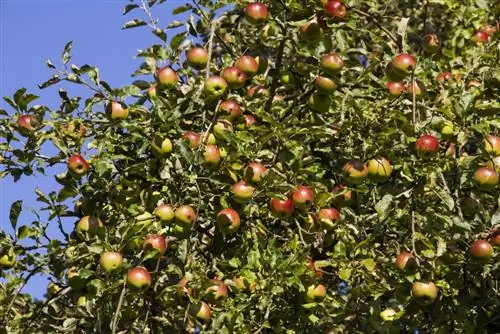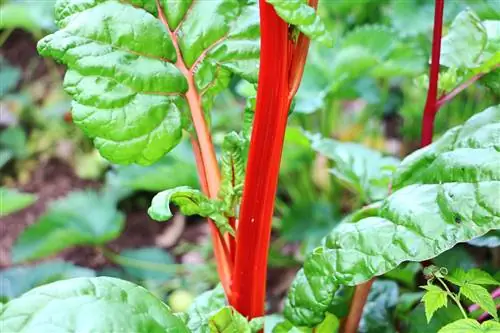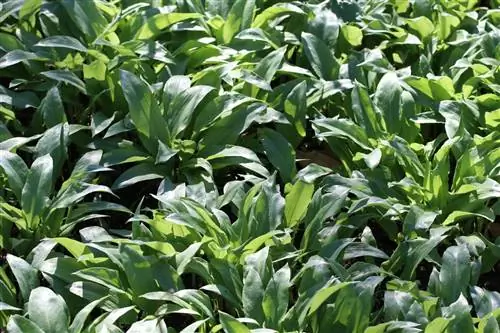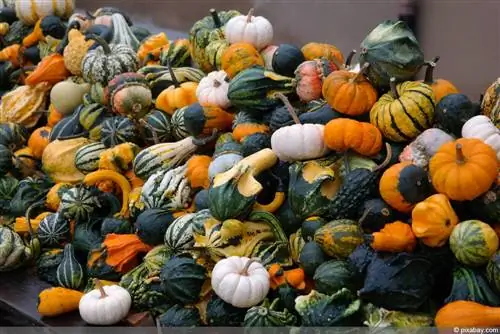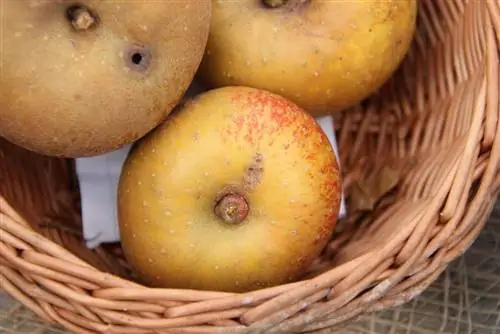- Author admin [email protected].
- Public 2023-12-17 03:39.
- Last modified 2025-01-24 12:45.
An apple tree not only provides shade in the home garden, but also provides the hobby gardener with numerous fruits when cared for professionally. If you prefer sour apples, you would be well advised to grow a Boskoop! This winter apple has a particularly high acid content, which is why it is particularly suitable for applesauce or baked apples.
Location
The Boskoop is a very vigorous apple tree that grows both in height and width. The hardy tree can reach a height of up to 4.5 meters and forms a particularly expansive crown over the years. When choosing a location, it is important to ensure there is enough space, with a planting distance of at least two meters being maintained. It should also not be placed too close to walls or buildings, especially since the shallow root system could lift the stones from paved paths. The Boskoop also grows best when the location meets the following requirements:
- Climate not too harsh
- A humid place is ideal
- full sun to partial shade
- too much shade affects the flowering
Tip:
In particularly cold regions, it is advisable to grow the Boskoop in a place protected from the wind. Because its flowers are extremely sensitive and could be destroyed by frost.
Neighbors
Unfortunately, the cultivation and professional care of an apple tree does not promise a productive harvest. Because all apple trees are considered self-infertile and therefore need a pollinator. In order for the pollinator tree to act as a pollen donor, it must be within a radius of around 20 to 30 meters and bloom at the same time as the Boskoop. The following apple varieties are therefore very suitable as pollinators for the Boskoop:
- Berlepsch
- Cox Orange
- Idared
- James Grieve
- Jonathan
- Clear Apple
Floor
The Boskoop tolerates neither drought nor waterlogging, which is why the optimal substrate is crucial for the growth of the tree. Accordingly, sandy soils are less suitable, whereas deep humus-clay soils are considered optimal. To promote extensive growth of the winter apple, it is therefore advisable to plant it in a soil with the following characteristics:
- heavy and chalky
- moist
- moderately nutritious
- slightly angry, neutral
Planting
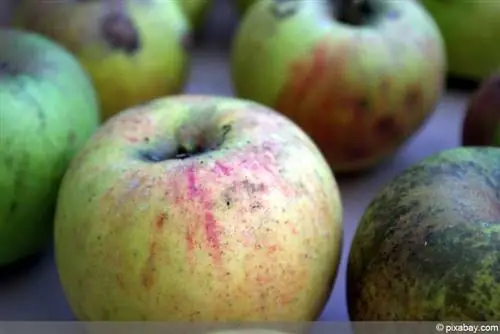
Fruit trees are usually purchased as container goods, which means they can be used all year round. However, it is advisable to plant the Boskoop either in spring or autumn. However, if the tree is planted in the ground in summer, it must be watered daily in order to grow at all. To make planting as stress-free as possible for the tree, the root ball should be left in water for a few hours. The Boskoop can then be planted as follows:
- Dig up planting hole
- about twice the size of the root ball
- Loosen the soil in the planting hole well
- cut off damaged roots
- Place the tree upright and in the middle
- Groping point about 10 cm above the surface of the earth
- Fill the hole with soil
- ideally mix in some compost
- shake the tree carefully from time to time
- so that the soil settles well
- Tread the earth carefully
- wash thoroughly
Support
Newly planted apple trees are at risk of snapping in strong gusts of wind. It is therefore advisable to provide the young trees with a support so that they cannot tip over in strong winds. There are various methods available for this, with supporting the Boskoop using a simple stake being particularly suitable. This is best applied before planting as follows:
- hammer in at the edge of the planting hole
- about 15 cm deep
- Distance to tree trunk at least 20 cm
- Tie the tree to the post
- best with a coconut rope
- Tightly knot the ends of the rope
Fertilize
Freshly planted apple trees usually do not require any additional fertilizer in their first few years. Ideally, the soil was enriched with compost when planting, which will supply the trees with sufficient nutrients for the coming months to years. In the following years, however, the apple tree can be fertilized, preferably using organic fertilizers. However, it is important to ensure that over-fertilization should always be avoided. This promotes growth, but at the expense of fruit production. When fertilizing, the following should therefore be observed:
- Organic slow-release fertilizers are best
- e.g.: manure or compost
- fertilization is carried out in spring and in May or June
- do not fertilize from June onwards
- Shoots cannot otherwise mature
Tip:
Falling leaves are ideal as a natural fertilizer because when they rot, they release valuable nutrients into the tree.
Pouring
The Boskoop wants to be watered regularly because it is sensitive to both dryness and waterlogging. An insufficient water supply can be seen, among other things, in the fruits splitting open or falling off. However, a subsoil that is too wet can significantly damage the he alth of the tree. Therefore, a bit of sensitivity is required when watering, and the following tips are useful:
- water approximately every week
- the upper layer of soil should never dry out completely
- Water soil well up to 20 cm deep
- best with rainwater
- Stale tap water is also suitable
Tip:
A generous layer of mulch not only supplies the tree with nutrients, but also reduces water evaporation.
Cutting

Apple trees are usually pruned once a year, although young trees are excluded. Pruning can be done in both spring and autumn as long as temperatures are above 5 degrees. Regular pruning not only keeps the shape of the tree crown in shape, but also promotes the he alth of the plant. If the tree is thinned out regularly, the risk of “alternancy” is reduced. This is a fluctuation in the fruit yield, so that the tree only bears large fruits every two years. It is therefore advisable to cut off the following shoots every year:
- dead and diseased branches
- shoots growing downwards and inwards
- obstructing branches
- Competitors to the leading branches
- Competitors to the middle branch
- Water shoots (shoots growing upwards)
When cutting, make sure that three to four leading branches are retained, otherwise numerous water shoots will form again. The fruit wood should also not be cut off, as this is where the flowers and subsequently the fruits form. However, these can be shortened in exceptional cases if the shoots grow particularly downwards. Make sure that you cut just above a bud that faces outwards.
Propagation
The Boskoop can be propagated by sowing, but this method is not necessarily recommended. As a rule, the plants are comparatively weak and hardly bear any fruit. However, propagation through grafting is more common and also more promising, although inoculation is particularly recommended for the Boskoop. Although this method requires some sensitivity, it is particularly popular among hobby gardeners. In order to propagate the Boskoop using inoculation, you first need a scion and a rootstock:
Scion rice
- is gained from the mother tree
- mature, pencil-thick shoot
- Cut the leaves
- only stubs should remain
Underlay
- comes from the same botanical family
- preferably a weakly growing apple tree
- remove all secondary shoots
Occulation Instructions
After both the scion and the rootstock have been prepared for inoculation, the actual grafting can continue. To do this, a T-shaped cut is first scratched into the bark of the base and then the bark is removed and unfolded. The eye is then removed from the scion as follows and inserted into the base:
- cut a bud from the middle part of the scion
- best to have a well-trained eye
- cut from below towards the shoot tip
- only cut through the bark, not deeper
- Push the precious eye from above into the T-cut of the base
- Cut off the excess of the eye flush
- best with a horizontal T-cut
- Wrap the finishing point
- raffia or a ribbon is suitable for this
- Seal the cut with tree wax or precious resin
Note:
If the inoculation was successful, a freshly sprouted eye will appear the following spring.
Harvesting and storage
The Boskoop is usually harvested from mid-October to November, but the fruits are not yet edible then. The Boskoop is one of the winter apples that require a so-called ripeness for consumption after the harvest in order to develop their full aroma. The ripeness for consumption lasts approximately from December to April, although it only begins during storage. In order for the Boskoop to develop its strong aroma, the following factors must be taken into account when harvesting and storing:
- Harvest fruit late
- this extends the shelf life
- Storage at around 3-4 degrees
- Apples last until about April
Tip:
If the apples become shriveled during storage, this is not a cause for concern. The fruits have lost water, but this makes the taste particularly intense.
Diseases and pests
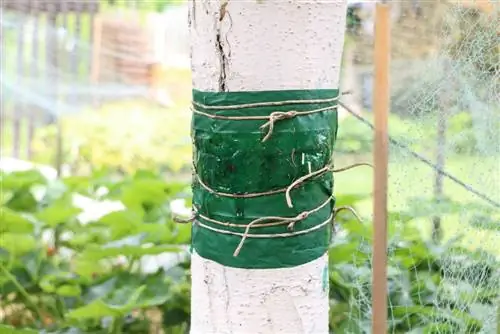
The Boskoop is particularly susceptible to core rot, which can only be seen when the fruit is cut open. Rot is characterized by a reddish-brown discolored core, and the discoloration can spread to the entire fruit. To prevent core rot, annual pruning and removing fruit mummies are recommended. It is also advisable not to harvest the apples too late and to ensure that the fertilizers have a low nitrogen content. In addition to core house rot, the following diseases and pests also pose a danger to the Boskoop:
- flesh tan
- Collar Rot
- codling moth
- Aphids
Note:
The Boskoop is considered to be less susceptible to scab and mildew.

